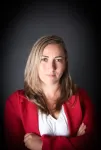(Press-News.org) An investigational gene therapy for a rare neurodegenerative disease that begins in early childhood, known as giant axonal neuropathy (GAN), was well tolerated and showed signs of therapeutic benefit in a clinical trial led by the National Institutes of Health (NIH). Currently, there is no treatment for GAN and the disease is usually fatal by 30 years of age. Fourteen children with GAN, ages 6 to 14 years, were treated with gene transfer therapy at the NIH Clinical Center and then followed for about six years to assess safety. Results of the early-stage clinical trial appear in the New England Journal of Medicine.
The gene therapy uses a modified virus to deliver functional copies of the defective GAN gene to nerve cells in the body. It is the first time a gene therapy has been administered directly into the spinal fluid, allowing it to target the motor and sensory neurons affected in GAN. At some dose levels, the treatment appeared to slow the rate of motor function decline. The findings also suggest regeneration of sensory nerves may be possible in some patients. The trial results are an early indication that the therapy may have favorable safety and tolerability and could help people with the rapidly progressive disease.
“One striking finding in the study was that the sensory nerves, which are affected earliest in GAN, started ‘waking up’ again in some of the patients,” said Carsten G. Bonnemann, M.D., senior author and chief of the Neuromuscular and Neurogenetic Disorders of Childhood Section at the National Institute of Neurological Disorders and Stroke (NINDS), part of NIH. “I think it marks the first time it has been shown that a sensory nerve affected in a genetic degenerative disease can actually be rescued with a gene therapy such as this.”
Participants in this “first-in-human” trial, which began in 2015, received a single dose of the gene therapy, called scAAV9/JeT-GAN, through an injection into the fluid surrounding the spine. The first two patients received the lowest dose of the gene transfer, which was increased in subsequent patients. Four dose levels were tested over the course of the trial, which were estimated based on results from studies in animal models. Only one serious adverse event – a fever – was potentially linked to the gene therapy. The treatment resulted in 129 related adverse events of lesser seriousness, including headache, back pain, irregular heart rhythms, and inflammation in spinal fluid that was treated with corticosteroids. Two patients who were older and received the lowest-dose therapy died during the study period due to events related to their underlying disease.
In addition to safety, Dr. Bonnemann and his colleagues also assessed motor function scores and tests of nerve function among the study participants. With increasing dose levels, they found the probability of any slowing of motor decline was 44%, 92%, 99%, and 90%, respectively. As GAN progresses, electrical measures of sensory nerves decline and eventually disappear. With gene therapy, 6 of 14 patients regained sensory nerve response after treatment—electrical measures increased, stopped declining, or became measurable after being absent.
Mutations to the GAN gene result in an inability to break down intermediate filaments, which are cellular structures that make up the framework of nerve cell extensions called axons. Axons are essential for transmission of signals between brain cells. The disease name refers to the enlarged and bloated appearance of the axon under the microscope. As GAN progresses, the axons of motor and sensory nerves break down, resulting in difficulty with movement and sensation because nerve cells cannot communicate with each other.
The first symptoms of GAN are often a clumsy and unsteady gait, becoming evident as early as 2 or 3 years of age. The disease progresses so that by age 8 or 9, patients typically require the use of a wheelchair, followed by increasingly limited use of the arms and little to no use of their legs. In the later stages, people with GAN often require breathing assistance and a feeding tube.
This trial could also benefit gene therapy for other diseases. Researchers testing other gene therapies have already adopted direct administration into the spinal fluid, which requires lower doses compared to usual delivery into the bloodstream by vein. Injecting into the spinal fluid also reduces the likelihood of an immune response, which enables patients who have developed immunity to adeno-associated virus (AAV), the common virus used as the gene delivery system in the therapy, to potentially receive treatment. Previously, children carrying antibodies to AAV from natural exposure to the virus would have been excluded from gene therapy because of their immune reaction.
Scientists will continue evaluating the scAAV9/JeT-GAN therapy to refine the treatment. Next, investigators plan to test whether the GAN gene transfer is more effective when given to younger children or those in an earlier stage of the disease. The next phase of the trial will help to further determine its safety and efficacy.
The study was supported by NINDS and the National Institute of Arthritis and Musculoskeletal and Skin Diseases, Hannah’s Hope Fund, Taysha Gene Therapies Inc., Bamboo Therapeutics/Pfizer Inc., Child Neurology Society, and the American Society of Gene and Cell Therapy. Hannah’s Hope Fund was integral in the development of the therapy, which was then advanced through collaborative efforts involving academia, industry, and government organizations. Clinical trial: NCT02362438
Citation: Bharucha-Goebel, DX, et al., Intrathecal Gene Therapy for Giant Axonal Neuropathy. NEJM. 21 March 2024. DOI: 10.1056/NEJMoa2307952
###
NINDS is the nation’s leading funder of research on the brain and nervous system. The mission of NINDS is to seek fundamental knowledge about the brain and nervous system and to use that knowledge to reduce the burden of neurological disease.
About the National Institutes of Health (NIH): NIH, the nation's medical research agency, includes 27 Institutes and Centers and is a component of the U.S. Department of Health and Human Services. NIH is the primary federal agency conducting and supporting basic, clinical, and translational medical research, and is investigating the causes, treatments, and cures for both common and rare diseases. For more information about NIH and its programs, visit https://www.nih.gov.
END
Experimental gene therapy for giant axonal neuropathy shows promise in NIH clinical trial
Treatment for rare childhood disease was well tolerated and slowed loss of motor function
2024-03-20
ELSE PRESS RELEASES FROM THIS DATE:
TIFRH study reports scalable and cost-effective method to assemble a safer and durable lithium metal battery
2024-03-20
Lithium metal batteries (LMBs) can provide nearly 10 times higher energy density compared to the present Lithium-ion batteries (LIBs) and hence are identified as one of the potential future storage systems. However, LMBs pose certain safety concerns and cannot be used for fast-charging applications. Uncontrolled dendrite formation, leading to excessive heating and battery short circuit is one of the critical challenges of its advancement.
Researchers have previously attempted to address the safety concerns in LMBs but with methods that were laboursome and money/time intensive. T. N. Narayanan’s lab at the Tata Institute ...
Pediatric cancer research foundation expands executive leadership team
2024-03-20
IRVINE, CA, March 20, 2024 --The Pediatric Cancer Research Foundation (PCRF), a nonprofit focused on transforming pediatric cancer care by funding research breakthroughs, today announced the expansion of its leadership team. Executive Director Jeri Wilson, who has led the organization for 12 years, will step into the newly created role of Vice President of Development, Principal Gifts. Danielle Fragalla, a known nonprofit leader in California, will become Chief Executive Officer.
In the 12 years Ms. Wilson has led the Foundation, it has grown from a grassroots ...
Analytical validation of NeXT Personal®, an ultra-sensitive personalized circulating tumor DNA assay
2024-03-20
“These results suggest strong potential for clinical use of the assay in ctDNA monitoring of solid tumor cancers.”
BUFFALO, NY- March 20, 2024 – A new research paper was published in Oncotarget's Volume 15 on March 14, 2024, entitled, “Analytical validation of NeXT Personal®, an ultra-sensitive personalized circulating tumor DNA assay.”
In this new study, researchers Josette Northcott, Gabor Bartha, Jason Harris, Conan Li, Fabio C.P. Navarro, Rachel Marty Pyke, Manqing Hong, Qi Zhang, Shuyuan Ma, Tina X. Chen, Janet Lai, Nitin Udar, Juan-Sebastian Saldivar, Erin Ayash, ...
Research suggests how turbulence can be used to generate patterns
2024-03-20
The turbulent motion of a tumbling river or the outflow from a jet engine is chaotic: that is, it contains no obvious pattern.
But according to a new study, regular patterns can emerge from the turbulent motion of fluids. What you need is an intriguing property called “odd viscosity” that arises under certain conditions, such as when the particles in the fluid all spin in the same direction. Though it’s a specialized circumstance, there are many contexts in nature where a version of this effect may exist, such as in the ...
Treating anxiety, depression significantly impacts heart disease outcomes
2024-03-20
COLUMBUS, Ohio — Treating anxiety and depression significantly reduced emergency room visits and rehospitalizations among people with heart disease, according to a study by researchers at The Ohio State University Wexner Medical Center.
“For patients hospitalized for coronary artery disease or heart failure and who had diagnoses of anxiety or depression, treatment with psychotherapy, medication or both was associated with as much as a 75% reduction in hospitalizations or emergency room visits. In some cases, there was a reduction in death,” said lead study author Philip Binkley, MD, executive ...
University of Oklahoma-led study receives best paper award from unconventional resources conference
2024-03-20
A study led by University of Oklahoma researchers has been selected for a 2023 best paper award in the Advanced Formation Evaluation technical program theme from the Unconventional Resources Technology Conference.
The study examined how clay and kerogen, two different components within rocks, respond to nuclear magnetic resonance, or NMR, a technique used to assess the amount of fluids within rocks. Many fluids found within rocks contain hydrogen, and knowing whether and how much hydrogen is available in the subsurface is an important facet of oil and gas exploration. Researchers found that higher NMR frequencies improved data acquisition efficiency.
As a result of this study, a ...
FoxO6-mediated ApoC3 upregulation promotes hepatic steatosis and hyperlipidemia in aged rats fed a high-fat diet
2024-03-20
“This discovery unveils a potential novel molecular target for therapeutic strategies against hepatic steatosis during the aging process [...]”
BUFFALO, NY- March 20, 2024 – A new research paper was published in Aging (listed by MEDLINE/PubMed as "Aging (Albany NY)" and "Aging-US" by Web of Science) Volume 16, Issue 5, entitled, “FoxO6-mediated ApoC3 upregulation promotes hepatic steatosis and hyperlipidemia in aged rats fed a high-fat diet.”
FoxO6, an identified factor, induces hyperlipidemia and hepatic steatosis during aging by activating hepatic ...
Dr. Cochav Elkayam-Levy awarded the Israel Prize for her work to raise awareness of Hamas’ crimes against humanity against Israeli women, children, men, and families
2024-03-20
Dr. Cochav Elkayam-Levy, of the Hebrew University of Jerusalem awarded the Israel Prize in the field of Solidarity (Arvut Hadadit) for her tireless work to raise awareness and acknowledgement to the crimes committed by Hamas on and following October 7th against Israeli women, children, men and families. Elkayam-Levy established the “Civil Commission on October 7th Crimes by Hamas against Women and Children”, aimed at giving voice to the victims and their families and raising awareness of the concerning developments in war crimes against women, children, men and families on and after October 7th and raising support for this cause.
Dr. Cochav Elkayam-Levy: ...
Partisanship influences consumer confidence, spending more than expected
2024-03-20
A new study from the University of Florida's Bureau of Economic and Business Research (BEBR) has found that national elections have a greater impact on consumer sentiment and spending intentions than previously thought, especially during transitions of power between political parties. Led by Hector Sandoval, director of the Economic Analysis Program and research assistant professor at BEBR, the study draws on years of meticulous observation and analysis of monthly sentiments data collected by the UF Survey Research Center.
Despite the wealth of data available ...
AI can now detect COVID-19 in lung ultrasound images
2024-03-20
Artificial intelligence can spot COVID-19 in lung ultrasound images much like facial recognition software can spot a face in a crowd, new research shows.
The findings boost AI-driven medical diagnostics and bring health care professionals closer to being able to quickly diagnose patients with COVID-19 and other pulmonary diseases with algorithms that comb through ultrasound images to identify signs of disease.
The findings, newly published in Communications Medicine, culminate an effort that started early in the pandemic when clinicians needed tools to rapidly assess legions of patients in overwhelmed emergency rooms.
“We developed ...
LAST 30 PRESS RELEASES:
Air pollution exposure and birth weight
Obstructive sleep apnea risk and mental health conditions among older adults
How talking slows eye movements behind the wheel
The Ceramic Society of Japan’s Oxoate Ceramics Research Association launches new international book project
Heart-brain connection: international study reveals the role of the vagus nerve in keeping the heart young
Researchers identify Rb1 as a predictive biomarker for a new therapeutic strategy in some breast cancers
Survey reveals ethical gaps slowing AI adoption in pediatric surgery
Stimulant ADHD medications work differently than thought
AI overestimates how smart people are, according to HSE economists
HSE researchers create genome-wide map of quadruplexes
Scientists boost cell "powerhouses" to burn more calories
Automatic label checking: The missing step in making reliable medical AI
Low daily alcohol intake linked to 50% heightened mouth cancer risk in India
American Meteorological Society announces Rick Spinrad as 2026 President-Elect
Biomass-based carbon capture spotlighted in newly released global climate webinar recording
Illuminating invisible nano pollutants: advanced bioimaging tracks the full journey of emerging nanoscale contaminants in living systems
How does age affect recovery from spinal cord injury?
Novel AI tool offers prognosis for patients with head and neck cancer
Fathers’ microplastic exposure tied to their children’s metabolic problems
Research validates laboratory model for studying high-grade serous ovarian cancer
SIR 2026 delivers transformative breakthroughs in minimally invasive medicine to improve patient care
Stem Cell Reports most downloaded papers of 2025 highlight the breadth and impact of stem cell research
Oxford-led study estimates NHS spends around 3% of its primary and secondary care budget on the health impacts of heat and cold in England
A researcher’s long quest leads to a smart composite breakthrough
Urban wild bees act as “microbial sensors” of city health.
New study finds where you live affects recovery after a hip fracture
Forecasting the impact of fully automated vehicle adoption on US road traffic injuries
Alcohol-related hospitalizations from 2016 to 2022
Semaglutide and hospitalizations in patients with obesity and established cardiovascular disease
Researchers ‘listen in’ to embryo-mother interactions during implantation using a culture system replicating the womb lining
[Press-News.org] Experimental gene therapy for giant axonal neuropathy shows promise in NIH clinical trialTreatment for rare childhood disease was well tolerated and slowed loss of motor function






